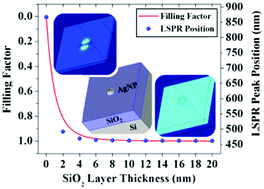Impact of ultrathin dielectric spacers on SERS: energy transfer between polarized charges and plasmons†
Abstract
The optical properties of plasmonic nanoparticles and substrates have been exploited to produce vapour deposited substrates that are as effective as SERS substrates produced using sophisticated nanolithography. In this work, we show that introducing ultrathin dielectric spacers of ∼5 nm between the silicon substrate and the silver nanoparticles provides adequate screening and allows for energy transfer between the plasmons and polarization charges of the high-permittivity silicon, a desirable feature for SERS enhancement. We show this effect using different dielectric spacers of silicon dioxide, silicon nitride and others. Note that the energy transfer process is active for distances <10 nm and falls as 1/d6 (where d is the thickness of the spacer), and larger spacers asymptotically approach the radiative regime of thin-film interference with an intermediate non-radiative regime (d ∼ 10–40 nm). Enhancement of Raman scattering signals by factors close to 105 has been observed from these substrates that can be easily produced on large areas. The experimental studies were complemented by COMSOL numerical results showing the shifting and enhancement of plasmon resonances of the silver particles due to the spacers predicting similar enhancements. We also present a radiation model of the silicon substrate and silver particles with an interleaving boundary-layer of such induced permittivity that predicts these experimental observations equally well.



 Please wait while we load your content...
Please wait while we load your content...